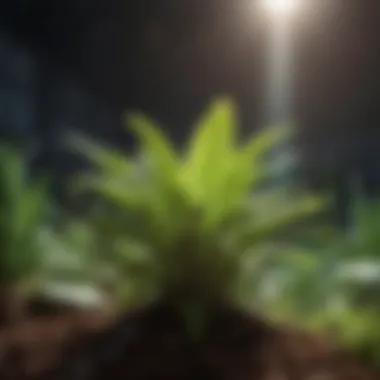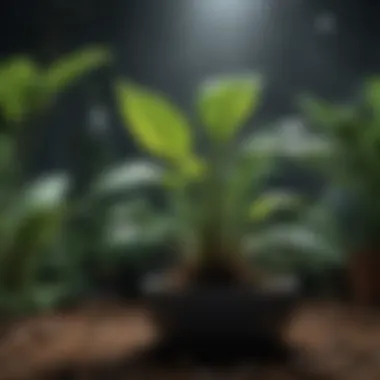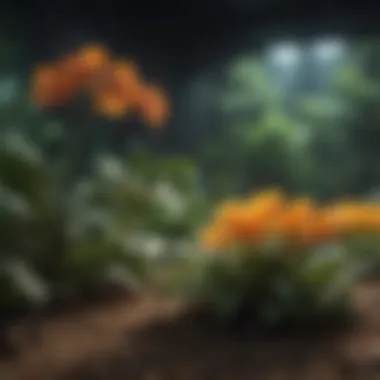Optimal Light Spectra and Their Impact on Plant Growth


Intro
Importance of Light Spectrum
Light is not just light; it consists of multiple wavelengths that plants utilize differently. Blue light, generally in the range of 400 to 500 nm, is essential for vegetative growth and development. Meanwhile, red light, around 600 to 700 nm, plays a vital role in flowering and fruiting. Understanding these requirements aids in aligning light conditions appropriately for different stages of plant growth.
This section will delve into key insights into how light spectra interact with plant physiology and contribute to enhanced growth rates.
Practical Applications in Agriculture
The advancement of horticultural lighting technology has opened avenues for optimizing plant growth. LED lights with adjustable spectra allow growers to tailor lighting to specific plant needs. However, knowledge of which wavelengths to apply for optimal results must guide these decisions.
In controlled environments, such as greenhouses or hydroponics, the ability to manipulate light can lead to significant increases in yield. Farmers increasingly turn to technologies that provide precise lighting conditions, thus ensuring a more predictable and successful cultivation.
Moreover, ongoing research contributes to the understanding of light's role in plant health, exploring how certain light spectra can enhance disease resistance or influence nutrient uptake.
End and Future Directions
To enhance plant cultivation effectively, it is essential to comprehend the relationship between light spectra and plant physiology. This underpins the scientific understanding of plant growth and opens possibilities for innovative agricultural practices. As research unfolds, it will continue to inform strategies aimed at optimizing light for both indoor gardens and expansive farmlands.
The insights extracted from this study will benefit those keen on increasing their knowledge about plant cultivation modalities, providing a foundation upon which more effective practices can be developed.
Understanding Light Spectrum
Understanding the light spectrum is crucial for comprehending how light influences plant growth. Light is not merely bright; it has a spectrum that affects various biological processes. This section delves into the definition and components of light spectrum, as well as the specific wavelengths that play a role in plant health. By grasping the light spectrum's intricacies, caretakers and growers can optimize conditions for photosynthesis and overall plant development.
Definition and Components of Light Spectrum
The light spectrum encompasses different wavelengths of light, extending from gamma rays to radio waves. However, the pertinent range for plant growth lies primarily within the visible light spectrum, specifically between 400 to 700 nanometers. This range is where light interacts with chlorophyll and other pigments in plants, facilitating photosynthesis.
Components of the light spectrum include:
- Ultraviolet (UV) Light: Ranges from about 10 to 400 nanometers. It can be harmful in high doses but also plays a role in plant growth, especially in the production of certain protective compounds.
- Visible Light: The light visible to the human eye, comprising different colors. Each color has a specific wavelength and influences plant processes differently.
- Infrared Light: Ranges from about 700 nanometers to 1 millimeter. While not used directly for photosynthesis, it is critical for plant heat regulation.
Understanding these components can aid in determining which wavelengths are beneficial for specific plants. The balance of these light types affects how plants grow, bloom, and even resist diseases.
Wavelengths and Colors in Light Spectrum
Colors within the visible light spectrum are not just aesthetic; they hold significant importance for plant growth. Each color corresponds to a specific wavelength that elicits particular responses from plants. For example:
- Blue Light (400-500 nm): This wavelength promotes vegetative growth. Plants require blue light for robust leaf and stem development.
- Green Light (500-550 nm): While often seen as less effective, some plants utilize green light for photosynthesis in shaded conditions.
- Red Light (600-700 nm): This wavelength encourages flowering and fruiting. It is particularly potent in promoting flowering in various plant species.
Research indicates that supplementing red light in indoor growing environments can substantially increase yield and efficiency.
Utilizing the appropriate wavelengths not only accelerates growth but also ensures plants develop healthily. Assessing the specific light needs of various plants can empower growers to tailor their lighting strategies more effectively.
Importance of Light in Plant Growth
Light plays a fundamental role in the life cycles of plants. Understanding its importance is crucial for anyone involved in agriculture, gardening, or any plant-related fields. This section details how light influences photosynthesis, and consequently, plant growth and productivity.
Photosynthesis Basics
Photosynthesis is the process through which plants convert light energy into chemical energy. This process mainly occurs in the chloroplasts, where chlorophyll absorbs specific wavelengths of light. It requires carbon dioxide and water, producing oxygen and glucose as byproducts. Glucose serves as energy for growth, reproduction, and maintenance.
The light spectrum is absorbed by chlorophyll primarily in the blue (400-500 nm) and red (600-700 nm) ranges. These wavelengths boost the rate of photosynthesis efficiently. The efficacy of this process hinges on the quality and quantity of light available.
Photosynthesis can be simplified into two main stages:
- Light-dependent reactions: These take place in the thylakoid membranes of chloroplasts. Light energy splits water molecules, resulting in ATP and NADPH production.
- Light-independent reactions (Calvin Cycle): Utilizing the ATP and NADPH produced, carbon dioxide is converted into glucose. This reaction can even occur in the absence of light, given that sufficient ATP is present.


In summary, sufficient light is not just beneficial; it is essential for optimal photosynthetic rates, which in turn lead to healthy, robust plants.
Role of Light in Plant Development
Light does more than just aid in photosynthesis. It influences various developmental processes in plants, such as germination, elongation, and flowering.
- Photomorphogenesis: This term refers to the growth and development of plants in response to light. The presence of light impacts seed germination. Many seeds require light to break dormancy. Without adequate light, seedlings may stretch excessively, seeking brighter conditions. This elongation can result in weak, leggy plants incapable of sustaining themselves.
- Flower Initiation and Fruiting: Light duration affects flowering in many species. Plants tend to categorize themselves based on their light exposure—short-day plants, long-day plants, and day-neutral plants. Understanding the lighting requirements is critical for successful flowering and fruiting outcomes. For example, some plants only bloom when they receive a certain number of uninterrupted dark hours.
- Chlorophyll Production: Prolonged exposure to the right light spectrum promotes chlorophyll production. This is vital, as higher chlorophyll levels enhance photosynthetic efficiency. Further, this can greatly improve the overall health and vigor of the plants.
Plants use light not only as energy but also as informaton. They
Key Wavelengths for Plant Growth
Understanding key wavelengths is crucial for optimizing plant growth. Plants rely on specific light wavelengths for processes like photosynthesis. Each wavelength has unique effects on growth and development. By focusing on these key wavelengths, growers can better cater to their plants' needs. This section elaborates on the three main wavelengths relevant to plant growth: blue light, red light, and green light. Each type has distinct roles and benefits.
Blue Light and Its Effects
Blue light typically ranges from 400 nm to 500 nm. It plays a significant role in plant processes. This wavelength is particularly important during the vegetative stage of growth. It helps regulate stomatal opening, enabling plants to breathe and transpire.
Benefits of Blue Light:
- Enhances chlorophyll production, leading to stronger plant growth.
- Promotes compact stature and encourages leafy growth.
- Affects phototropism, guiding plants toward optimal light sources.
Blue light also influences the circadian rhythms of plants, which can affect flowering and other biological processes. Its role in photosynthesis cannot be overstated. However, an excess of blue light may lead to stress in some species, so it's essential to maintain a balance.
Red Light and Its Role
Red light, ranging from 600 nm to 700 nm, is vital for plant growth. It has a direct effect on flowering and fruiting. Plants respond well to red light, especially in the flowering stage. This wavelength helps stimulate phytochromes, proteins that act as light receptors. They signal the plant when to flower.
Key Aspects of Red Light:
- Supports photosynthesis and encourages plant elongation.
- Promotes proper fruit development and ripening.
- Enhances overall plant metabolism.
When used in combination with blue light, red light helps create a balanced light environment for optimal growth. However, too much red light can lead to stretching as plants reach for more light, which can negatively impact overall health.
Green Light: Benefits and Misconceptions
Green light might seem less important, typically ranging from 500 nm to 600 nm. Many assume that plants do not utilize green light efficiently. However, recent studies reveal that it plays a role that is often overlooked. Green light penetrates deeper into the leaf tissue than red or blue light, which can aid in photosynthesis despite being reflected more.
Potential Benefits of Green Light:
- Assists in plant growth in shaded environments.
- Can enhance photosynthesis under specific conditions.
- Provides a fuller spectrum that promotes overall plant health.
Misconceptions:
- Some think green light is ineffective; it has its place in the light spectrum.
- Green light often used for aesthetic purposes in indoor gardening can still contribute to healthy growth.
Light Quality vs.
Light Quantity
The debate between light quality and light quantity is crucial for effective plant growth. Both elements play distinct roles in how plants absorb light and convert it into energy, ultimately affecting their overall health and yield. A deeper understanding of these components allows cultivators to optimize growing conditions, ensuring plants thrive.
Understanding Light Intensity
Light intensity refers to the amount of light that reaches a surface per unit time. For plants, intensity impacts photosynthesis directly. Higher intensity generally enhances the rate of photosynthesis, enabling plants to grow faster and healthier. However, excessive light can lead to photoinhibition, where too much light can damage the plant's cellular structure, reducing photosynthetic efficiency.
Several factors influence light intensity, including distance from the light source, the type of light used, and environmental conditions. When measuring light intensity, it's beneficial to use a quantum meter, which gives precise readings of photosynthetically active radiation (PAR).
Some key points to consider about light intensity include:


- Distance from the source: As a general rule, doubling the distance from a light source can reduce the light intensity to a quarter of what it would be at half the distance.
- Light source characteristics: Different artificial light sources, such as LED and fluorescent, emit varying intensities across different wavelengths. Understanding these characteristics helps in selecting the right light for specific plant needs.
Balancing Quality and Quantity for Optimal Growth
Balancing light quality and quantity is essential for achieving optimal plant growth. Quality refers to the specific wavelengths present, while quantity denotes the overall intensity of the light. Each factor is influential, but they must work in harmony.
Plants respond differently to varying light qualities. For example, blue light is critical for vegetative growth, whereas red light promotes flowering and fruiting. Therefore, utilizing a combination of these wavelengths can enhance growth cycles effectively.
Nevertheless, if only quantity is emphasized, quality may be compromised, leading to potential growth issues. Likewise, an over-focus on quality at the expense of quantity can stunt growth. Achieving a harmonious balance requires:
- Employing Full-Spectrum Lighting: Full-spectrum lights provide a balanced mix of wavelengths suitable for various plants at different growth stages.
- Monitoring Growth Responses: Regular observation can help identify how plants respond to the light conditions. Adjustments can then be made based on visual indicators.
In summary, understanding the interplay between light quality and quantity can help cultivators create ideal environments for their plants. The right balance leads to higher yields and better overall plant health, making it a fundamental concept in horticulture.
Different Light Sources for Plant Growth
Understanding the various light sources available for plant growth is essential. Different sources emit unique light spectra, influencing how effectively plants can photosynthesize and thrive. This section explores three prominent light sources: natural sunlight, LED technology, and fluorescent lights. Each plays a significant role in agriculture, whether it be in greenhouses, indoor farming, or commercial operations.
Natural Sunlight
Natural sunlight is often considered the gold standard for plant growth. It provides a balanced mix of wavelengths, benefiting photosynthesis and overall plant health. Exposure to sunlight stimulates various processes in plants, including flowering and fruiting.
Notable benefits of natural sunlight include:
- Full spectrum of light: It contains all wavelengths, essential for chlorophyll absorption.
- Cost-effective: It does not incur any additional costs, making it a sustainable choice for outdoor cultivation.
- Supports ecosystem health: Utilizing sunlight can positively impact surrounding wildlife, promoting biodiversity.
However, there are limitations. Location, seasonal changes, and weather conditions can affect sunlight quality and availability. Cloudy days or shorter daylight hours in winter can decrease light intensity. Therefore, supplemental lighting might be necessary in some cases to ensure optimal growth.
LED Technology
LED technology has gained popularity in recent years due to its efficiency and versatility. These lights can be customized to emit specific wavelengths that are advantageous for plant growth. LEDs are energy-efficient, producing less heat compared to traditional lighting, which reduces cooling costs for indoor operations.
Key features of LED lights include:
- Adjustable spectrum: Tailored light spectrums can enhance photosynthesis and the growth of specific plant types.
- Longevity: LED bulbs have a longer lifespan, reducing the need for frequent replacements.
- Energy savings: They consume less electricity, offering cost savings in the long term.
Despite advantages, initial setup costs for high-quality LED systems can be significant. Understanding the specific light needs of plants is crucial to ensure effective use of LED technology.
Fluorescent Lights
Fluorescent lights, widely used in indoor gardening, provide a good source of light for growing plants. They are particularly effective for seedlings and leafy greens, as their lower heat output prevents scorching.
Important aspects of fluorescent lights are:
- Diversity: Available in various types such as T5 and compact fluorescent lights, meeting diverse growth requirements.
- Cost-effective: Generally less expensive than LEDs, they can be an entry-level option for many growers.
- Good light spectrum: They emit primarily blue and red wavelengths suitable for photosynthesis.
However, fluorescent lights are not as energy-efficient as LEDs and may require more frequent replacements. They also produce more heat than LEDs, which can be a concern for delicate plants if not monitored.
Each lighting option has its pros and cons. Identifying the specific needs of the plants and the growing environment is crucial to making the best choice for optimized growth.
Applications in Commercial Agriculture
Applications of light spectra in commercial agriculture hold significant importance for improving efficiency and productivity. Understanding how to manipulate light can lead to better plant growth, increased yields, and optimized resource use. Different environments, such as greenhouses and hydroponics, benefit from tailored lighting solutions to meet specific growth requirements.
The integration of suitable light spectra can also enhance the overall health of crops, making them more resistant to diseases and pests. This is crucial in commercial settings where the economic stakes are high. Moreover, growing conditions can be calibrated according to various plant needs which can result in substantial cost savings in terms of energy and resource consumption.
Greenhouse Operations
In greenhouse operations, lighting becomes a pivotal factor in achieving optimal growth conditions. Greenhouses often rely on supplemental lighting, especially in regions or seasons with limited sunlight. Using targeted light spectra that include the right amounts of blue and red wavelengths ensures plants receive proper energy for photosynthesis, which results in vigorous growth.


- **Benefits:
- Enhanced photosynthesis can lead to faster growth rates.
- It can extend the growing season, allowing for multiple harvests per year.
- It assists in maintaining consistent plant quality.
- Reduces the reliance on pesticides by promoting healthy plant growth.**
It's essential for greenhouse managers to consider the intensity and duration of light exposure. Too much light can cause stress in plants, while too little can stunt growth. An effective balance is key to a successful greenhouse environment.
Hydroponics and Indoor Farming
Hydroponics and indoor farming expose new challenges that require unique solutions. Lighting systems in these setups are designed to be versatile, delivering optimal light to plants grown without soil. Using specific spectrums frequently results in faster growth and higher yields compared to traditional methods.
- **Considerations:
- Full spectrum lighting can mimic natural sunlight, which is beneficial for plant development.
- Different plant species may require distinct light spectrums, necessitating a flexible lighting approach.
- Light systems, specifically LEDs, are energy efficient and emit less heat, reducing cooling costs.
- Control systems can be used to monitor and adjust light conditions according to plant growth stages.**
Research shows that plants grown in these optimized environments not only grow faster but are also more flavorful and nutrient-dense. Investing in suitable lighting technology is essential for those engaged in hydroponics and urban gardening, where maximizing space and yield is a priority.
“The right light can turn a small indoor setup into a thriving agricultural venture.”
Research and Innovations in Plant Lighting
The exploration of plant lighting solutions has grown significantly, leading to breakthroughs that directly influence agricultural practices. Understanding the latest research and innovations in plant lighting is crucial for growers aiming to maximize productivity and efficiency. These developments not only enhance the understanding of how light affects plant biology but also yield practical applications that can be implemented in various cultivation environments.
Research in this area often focuses on optimizing light spectrums to align with different growth phases of plants. This means that horticulturists can adjust light conditions based on specific needs, enabling better growth outcomes. For instance, studies show that specific wavelengths can enhance photosynthesis rates more efficiently at various stages of a plant’s life cycle. This efficiency translates to quicker harvests and higher yields,
For commercial applications, innovations like LED technology have democratized access to premium lighting options. By generating the desired light spectra without excessive heat, LED fixtures have become favored for both indoor and greenhouse settings. Newer models often include smart technology, allowing growers to program light schedules or adjust light intensities remotely.
Challenges of Artificial Lighting
The use of artificial lighting in plant growth presents unique challenges that must be carefully considered. While providing the necessary light spectrums for photosynthesis and plant development, these methods often come with significant drawbacks. Understanding these challenges is crucial for optimizing plant care and ensuring sustainable agricultural practices.
Energy Consumption and Costs
Artificial lighting systems, particularly those used for indoor gardens or commercial greenhouses, require substantial energy. The type of lighting technology selected can greatly influence the overall power consumption. For example, while LED lights tend to use less energy compared to HID lamps, they can still contribute to elevated electricity bills.
Factors affecting energy consumption include:
- Type of Light Source: LEDs, fluorescent lights, or incandescent bulbs each have different energy efficiencies.
- Duration of Use: Continuous exposure to artificial light can ramp up energy costs, affecting economic viability.
- Environmental Controls: Systems that regulate light duration and intensity require additional energy for operation.
Proper planning and selection of lighting can help mitigate these costs. For instance, using smart timers or sensors can ensure that lights only operate when necessary. In this way, growers can minimize waste and reduce their carbon footprint while maintaining optimal light conditions for plants.
Light Pollution and Its Effects
Light pollution is another significant concern associated with artificial lighting in agriculture. This phenomenon occurs when artificial light disrupts the natural darkness of the environment. It can have detrimental effects on both plants and local ecosystems.
Impacts of light pollution include:
- Disruption of Growth Cycles: Many plants rely on natural light cues for flowering and fruiting. Excessive artificial light can throw off these cycles.
- Effects on Wildlife: Local fauna may alter their behaviors due to unexpected light conditions. This can lead to ecological imbalances.
- Human Health Concerns: Light pollution is not just an environmental issue. It can also affect human well-being by disrupting sleep patterns and contributing to various health problems.
Addressing light pollution requires thoughtful placement and design of artificial lighting systems. For example, using directional lighting can minimize unnecessary light dispersion into the environment. Moreover, implementing community guidelines on appropriate light usage can play a vital role in mitigation efforts.
It is necessary to balance plant needs with environmental impacts to promote sustainable practices in agriculture.
Epilogue
The conclusion of this article serves as a pivotal summary of the importance of understanding the light spectrum in relation to optimal plant growth. It synthesizes the insights presented throughout, emphasizing that each aspect discussed contributes to the overall health and productivity of plants. An optimal light spectrum not only enhances photosynthesis but also supports various developmental stages of plants. By recognizing the significance of specific wavelengths, growers can adjust their lighting strategies effectively.
Summary of Key Points
- Light spectrum influences photosynthesis, growth rates, and plant development.
- Different wavelengths like blue and red light play crucial roles in plant health.
- Quality of light is as important as quantity for optimal growth.
- Both natural sunlight and artificial lighting sources, such as LEDs and fluorescent lights, present unique advantages.
- Keeping energy consumption and light pollution in check is essential for sustainable agriculture practices.
Final Thoughts on Light Spectrum for Plant Growth
As we conclude, it is clear that understanding the nuances of light spectra is not just for scientists or agricultural technologists. Anyone invested in plant cultivation—from indoor gardeners to large-scale farmers—can benefit from harnessing this knowledge. Choosing the right light source and managing it well allows for significant enhancements in plant growth and yield. Every grower should consider implementing these insights to improve their cultivation practices.
Understanding light spectra is crucial; it is not merely a technical detail but a core principle in plant growth.
In promoting optimal growth conditions, evaluating the impacts of lighting technology becomes paramount. Continual research in this area will likely yield ongoing innovations and practical applications, leading to even better outcomes in horticultural practices.







